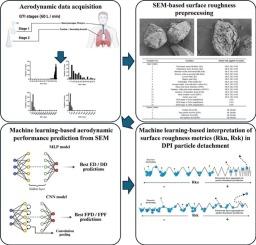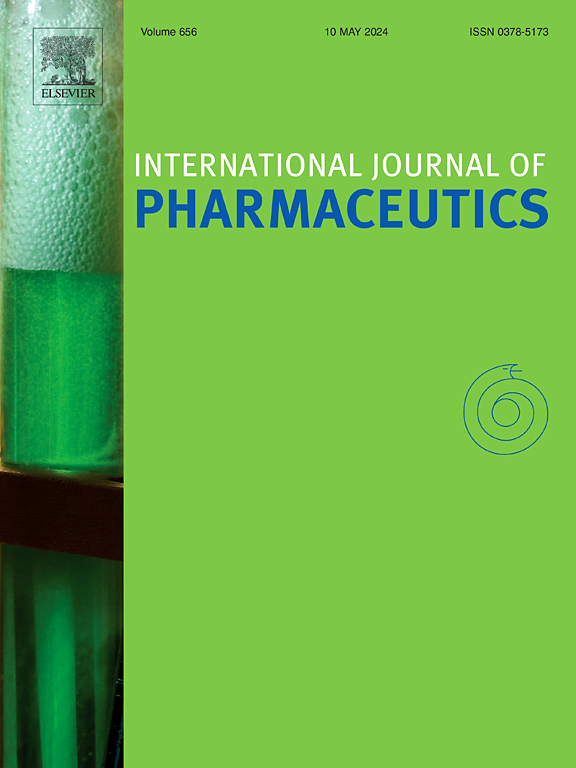Machine learning-based prediction of aerodynamic performance in arformoterol-lactose dry powder inhaler formulations using surface roughness features
IF 5.2
2区 医学
Q1 PHARMACOLOGY & PHARMACY
引用次数: 0
Abstract
Dry powder inhalers (DPIs) are widely used for pulmonary drug delivery, and their aerodynamic performance is highly dependent on particle surface morphology. This paper presents a machine learning-based framework to quantitatively predict DPI aerodynamic behavior using surface roughness parameters from scanning electron microscopy (SEM) images. Ten DPI formulations were prepared with various storage conditions and compositions. Thirteen surface roughness features were extracted using ImageJ and SurfCharJ and used as inputs for predictive models, including multilayer perceptrons (MLPs), support vector machines (SVMs), logistic regression (LR), and convolutional neural networks (CNNs). The models were trained to estimate the emitted dose (ED), delivered dose (DD), fine particle fraction (FPF), and fine particle dose (FPD).
Among the models, the MLPs paired with RF-based feature selection best predicted the ED and DD. CNNs trained directly on SEM images predicted FPF and FPD better. Surface roughness parameters kurtosis (Rku) and skewness (Rsk) were the most consistent critical predictors across all performance metrics, showing nonlinear relationships with the aerodynamic behavior and specific inflection thresholds associated with marked shifts in particle adhesion and detachment. Higher Rku and Rsk values indicated sharp and asymmetric surface structures and were associated with improved dispersion performance (higher DD, FPF, and FPD), but reduced ED, reflecting more efficient deaggregation.
Combining predictive modeling and mechanistic interpretation, this integrative approach provides a data-driven and interpretable basis for a rational arformoterol-lactose DPI formulation design. The results highlighted Rku and Rsk as practical morphological indicators optimizing the performance of inhalable dry powders in pulmonary drug delivery systems.

基于机器学习的阿福莫特罗-乳糖干粉吸入器配方空气动力学性能的表面粗糙度预测。
干粉吸入器(dpi)广泛用于肺部给药,其空气动力学性能高度依赖于颗粒表面形貌。本文提出了一个基于机器学习的框架,利用扫描电子显微镜(SEM)图像中的表面粗糙度参数定量预测DPI的空气动力学行为。在不同的贮存条件和组成条件下,制备了10种DPI制剂。使用ImageJ和SurfCharJ提取了13个表面粗糙度特征,并将其作为预测模型的输入,包括多层感知器(mlp)、支持向量机(svm)、逻辑回归(LR)和卷积神经网络(cnn)。对模型进行训练,以估计发射剂量(ED)、传递剂量(DD)、细颗粒分数(FPF)和细颗粒剂量(FPD)。其中,与基于rf的特征选择配对的mlp对ED和DD的预测效果最好,而直接训练SEM图像的cnn对FPF和FPD的预测效果更好。表面粗糙度参数峰度(Rku)和偏度(Rsk)是所有性能指标中最一致的关键预测指标,显示出与空气动力学行为和特定弯曲阈值的非线性关系,这些阈值与颗粒粘附和脱离的显著变化有关。较高的Rku和Rsk值表明表面结构尖锐和不对称,并与分散性能改善(更高的DD、FPF和FPD)相关,但降低了ED,反映了更有效的解聚。该方法结合预测建模和机理解释,为合理设计阿福莫特罗-乳糖DPI配方提供了数据驱动和可解释的基础。结果强调Rku和Rsk作为实用形态学指标优化肺给药系统中可吸入干粉的性能。
本文章由计算机程序翻译,如有差异,请以英文原文为准。
求助全文
约1分钟内获得全文
求助全文
来源期刊
CiteScore
10.70
自引率
8.60%
发文量
951
审稿时长
72 days
期刊介绍:
The International Journal of Pharmaceutics is the third most cited journal in the "Pharmacy & Pharmacology" category out of 366 journals, being the true home for pharmaceutical scientists concerned with the physical, chemical and biological properties of devices and delivery systems for drugs, vaccines and biologicals, including their design, manufacture and evaluation. This includes evaluation of the properties of drugs, excipients such as surfactants and polymers and novel materials. The journal has special sections on pharmaceutical nanotechnology and personalized medicines, and publishes research papers, reviews, commentaries and letters to the editor as well as special issues.

 求助内容:
求助内容: 应助结果提醒方式:
应助结果提醒方式:


